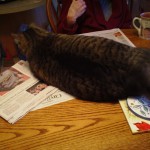As a long-time writing teacher, I’m always amazed at what some writers consider editing. A writer will inform me that they’ve done some editing on a piece I’ve seen before. Then when I read it, I can’t really spot those edits at all. They usually turn out to be a word substitution or even a punctuation fix.
Writing Tip for Today: While details DO matter, writers who’ve heard that Hemingway sweat bullets over a word choice sometimes get focused on the small stuff when it’s the overall story that needs attention. Here are some easy ways to self-edit for important and fixable issues:
- Use the One Sentence Test. Read over your scene or story. Then, express what happens in one sentence. If the answer is, “Mary and Ted sit at a table drinking tea and talking about the weather,” it’s a sure thing that you need the scene to accomplish more. The “One Sentence Test” is like the canary in the coal mine. If the scene can’t pass the test, it’s time to rewrite or jettison.
- Check for Action. A drafted scene is rarely sufficient if the biggest action comes in the form of a character’s mouth moving. Try to think of something a little different for the action the players do while imparting all this dialogue. Instead of scenes in confined spaces, such as characters eating or drinking (not much action), characters standing around or sitting around, get inventive. What would the effect be if they were doing yard work, washing dishes or riding horses down a beach? Remember the swashbuckler movies? A lot of the dialogue happens during sword fights. Get your characters moving now and then.
- Who’s on First? Finally, all scenes with only one character on stage for the duration turn into monologues. Check over your scenes and evaluate them by numbers on stage. If you inject too many one-character scenes into your work, it can feel isolated. The reader will crave interaction with other characters. Many writers use their POV character alone on stage in order to slide back story past the reader. Too many of these “sittin and thinkin” scenes are not as effective as interaction scenes. If you want to start making headway in your quest to learn the craft, don’t focus on word choice as much as on story movement and how the reader will experience the story. That’s the kind of self-editing that really makes a difference.






Thanks for sharing these nuts and bolts recommendations for a quick edit.
Great tips for a self-edit!
Thanks, Rich! I hope you’ll stop by often. Write on, Linda
Linda, I appreciate reading these tips. I am returning to a non-fiction work begun some years ago but put aside. As the bulk of this manuscript will be my writing of other women’s experiences, yet wrapped around a main theme, I can well see your tips being of help to me as I put all the pieces together. Thanks!
Lynn,
Good Luck with your old new nonfiction. Keep me posted on how it’s going! Thanks for your comment. ~Linda
Simple but straight forward tips. Self-editing can be the most difficult because we love our words so much. I always find after I put a piece aside I can see these kinds of edits more clearly.
I tell my students that words are like Doritos–we can make more! I agree that the lens clears after you let a piece “rest” awhile. Thanks for weighing in! ~Linda
Good points! Also, a balance in action in dialogue. Too much action in order to avoid “said” can be distracting and slowing of the pace, too, I think.
Margo, Interesting comment about action/dialogue. Some are so afraid to EVER use “said,” but I agree: ALWAYS adding a beat sometimes slows the pace too much. I predict this pendulum will swing back toward the occasional said. Write on! Linda